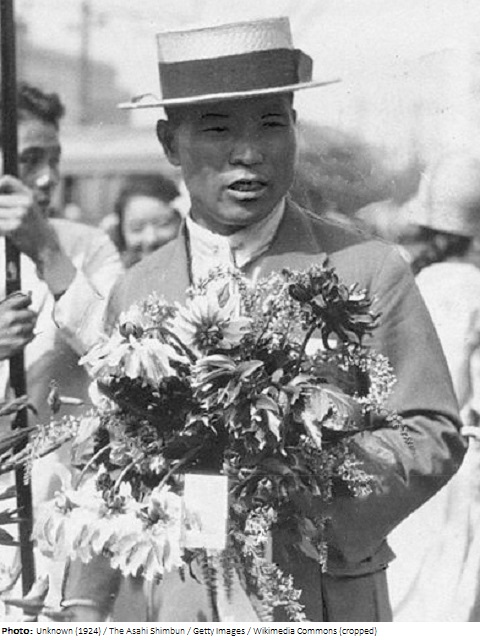Shizo Kanakuri

Biographical information
| Roles | Competed in Olympic Games |
|---|---|
| Sex | Male |
| Full name | Shizo•Kanakuri |
| Used name | Shizo•Kanakuri |
| Original name | 金栗•四三 |
| Born | 20 August 1891 in Wasui, Tamana, Kumamoto (JPN) |
| Died | 13 November 1983 (aged 92 years 2 months 24 days) in Tamana, Kumamoto (JPN) |
| Measurements | 170 cm / 64 kg |
| Affiliations | Tokyo Higher Normal School, Bunkyo (JPN) |
| NOC |  Japan Japan |
Biography
Kanakuri had a weak constitution as a child until he was 10-years-old and had to make a daily roundtrip of 12 km to attend high elementary school. He later received a scholarship allowing him to enroll in the Tokyo Higher Normal School in 1910. The following year, Kanaguri participated in the marathon trials for the Stockholm Olympics, setting what was claimed a world best of 2-32:45 over a distance of 25 miles (= 40.225 km). Together with sprinter Yahiko Mishima, he qualified to become the first Japanese Olympian.
Kanakuri had a difficult 18-day long trip to reach Stockholm for the 1912 Olympics. After travelling by ship and Trans-Siberian-Railway he had to rest for five days to be able to run the marathon. After 30 km of the Olympic marathon, suffering from the heat, he stopped at a house and asked the residents for a glass of water. The residents gave him water, and he lay down on a couch and fell asleep, awakening the next morning. Ashamed of his actions, he at first refused to return to Japan. In 1967 he returned to Stockholm at the age of 76 and finished his marathon run. Therefore, he has the “slowest” finishing time ever in an Olympic marathon with 54 years, 8 months, 6 days, 32 minutes and 20.3 seconds, a record surely not to be broken.
After returning to Japan, he started to adapt his training methods, including high-altitude training and what he called “heat resistance practice”. He also encouraged other youngsters to start long-distance running and shared with them his experiences. Two years after the Stockholm Olympics, he improved his time for the 25 miles to 2-19:20.3. This made him one of the favorites for the 1916 Berlin Olympics, which had to be canceled due to the outbreak of World War I. He went on to take part in the 1920 and 1924 Olympics. At Antwerpen, while he was still well up in the field close to the 40 km mark, he eventually hurt his legs and finished 16th. In Paris, he abandoned the race at approximately 32 km.
From 1917 on, he also entered long-distance walking and running relays, including the first prestigious Tokyo-Hakone Round-Trip College Ekiden Race (Hakone Ekiden). He also contributed greatly to the technical development of running shoes in Japan. Working as a teacher at various schools, he promoted women’s physical education, organizing the first women’s tennis tournament and forming the Kanto Women’s Sports Federation.
In the 1930s, Kanakuri further pursued his activities to promote the marathon and was involved in preparing the first Olympic Games in Japan, which eventually had to be returned. In 1945, he returned to his hometown Tamana to spent the rest of his life there. There, he became the first chairman of the Kumamoto Athletic Association and the Kumamoto Prefectural Chairman of Education and organized international marathons in Japan. He remained physically active until an old age and was called the “Father of Marathon in Japan”.
Personal Best: Mar – 2-36:09 (1924).
Results
| Games | Discipline (Sport) / Event | NOC / Team | Pos | Medal | As | |
|---|---|---|---|---|---|---|
| 1912 Summer Olympics | Athletics |  JPN JPN |
Shizo Kanakuri | |||
| Marathon, Men (Olympic) | ||||||
| 1920 Summer Olympics | Athletics |  JPN JPN |
Shizo Kanakuri | |||
| Marathon, Men (Olympic) | 16 | |||||
| 1924 Summer Olympics | Athletics |  JPN JPN |
Shizo Kanakuri | |||
| Marathon, Men (Olympic) |